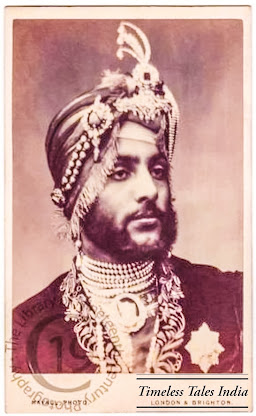Introduction:
Maharaja Duleep Singh, also known as the Black Prince of Perthshire, was a fascinating and enigmatic figure in the history of India and the British Empire. Born in 1838, he was the last ruler of the Sikh Empire, and his life was marked by extraordinary highs and tragic lows. After being dethroned and exiled to Britain, he found solace in the picturesque landscapes of Perthshire, Scotland, where he lived until his untimely death. This article delves into the life and legacy of Maharaja Duleep Singh, exploring his early years in India, his eventful journey to Britain, and his life in Perthshire.Part I: The Young Ruler of the Sikh Empire
Duleep Singh was born on September 4, 1838, in Lahore, Punjab, to Maharaja Ranjit Singh, the Lion of Punjab, and Maharani Jind Kaur. Following the death of his father, who had unified the Sikh Empire and brought stability to the region, Duleep Singh ascended to the throne at the tender age of five. However, his young age made him susceptible to manipulation by various factions within the empire.
The British East India Company saw an opportunity to exert control over the Sikh Empire and its vast wealth. In 1849, after the Second Anglo-Sikh War, the British annexed Punjab, and Duleep Singh's sovereignty was stripped away. The young Maharaja was coerced into signing the Treaty of Lahore, surrendering his kingdom and wealth to the British. He was also forced to leave his homeland and embark on a journey that would forever alter his life.
Part II: Exile and Conversion to Christianity
In the aftermath of the annexation, Duleep Singh was taken to Fatehgarh, then to Agra, where he was separated from his mother, Maharani Jind Kaur, and placed under the care of British guardians. His upbringing was influenced by British culture and education, and he converted to Christianity at the age of 15. The British believed that converting him would make him more amenable to their rule, but this move was met with resistance from the Sikh community, who saw it as a betrayal of their heritage.
Part III: Journey to Britain and Life in Exile
In 1854, at the age of 16, Duleep Singh was sent to Britain to complete his education and distance himself further from his Sikh roots. He was warmly received by Queen Victoria and the British aristocracy. The young Maharaja adapted well to his new surroundings and became a popular figure among the British elite. He was known for his charm, intelligence, and dashing looks, earning him the nickname "The Black Prince of Perthshire."
During his time in Britain, Duleep Singh traveled extensively and enjoyed a life of luxury, acquiring estates and properties, including the iconic Elveden Estate in Suffolk and later the grand Aberuchill Castle in Perthshire, Scotland. However, despite his seemingly content life, he grappled with a sense of alienation and a longing for his homeland.
Part IV: Quest for Identity and Return to Sikhism
As time passed, Duleep Singh grew increasingly introspective about his identity and heritage. He began questioning his conversion to Christianity and sought to reconnect with his Sikh roots. He corresponded with his mother, Maharani Jind Kaur, who remained a steadfast symbol of Sikh resistance against British rule. Their exchanges ignited a desire in him to rediscover his faith and culture.
In 1886, after years of soul-searching and inner conflict, Duleep Singh formally reconverted to Sikhism. He denounced his Christian faith and began wearing traditional Sikh attire. His actions were seen as a radical move, challenging the British establishment and their efforts to erase Sikh identity.
Part V: Final Years in Perthshire
Settling in his beloved Aberuchill Castle in Perthshire, Duleep Singh led a quieter and more contemplative life. He devoted himself to understanding and preserving Sikh heritage, collecting rare artifacts and historical documents related to Sikh history. He established connections with Sikh communities in Britain and worked towards promoting Sikh culture.
Tragically, Duleep Singh's life was cut short. He died at the age of 55 on October 22, 1893, in Paris, under mysterious circumstances. His body was later brought back to Britain and laid to rest in Elveden Estate, where a grand mausoleum was built in his honor.
Part VI: Legacy and Impact
Maharaja Duleep Singh's legacy extended far beyond his lifetime. His tumultuous journey and ultimate conversion back to Sikhism inspired a renewed sense of pride and identity among the Sikh diaspora. His struggles and the injustices faced by his family resonated with Sikhs worldwide, serving as a rallying cry for their own fight for justice and recognition.
The Elveden Estate, where Duleep Singh's remains were laid to rest, became a place of pilgrimage for Sikhs and a symbol of their resilience. The grand mausoleum, a fusion of Sikh and Victorian architectural styles, stands as a testimony to his enduring influence and the enduring connection between Britain and India.
Furthermore, Duleep Singh's efforts to collect and preserve Sikh artifacts and documents played a significant role in safeguarding the history and cultural heritage of the Sikh community. Today, his collection forms an integral part of various museums and exhibitions worldwide, allowing people to learn about the rich history of the Sikh Empire.
Part VII: Controversies and Debates
While Maharaja Duleep Singh's actions garnered admiration and respect from the Sikh community, they also raised controversies and debates among historians and scholars. Some criticized him for his early conversion to Christianity and claimed that he was merely a puppet of the British Empire. Others argued that his conversion was a result of the psychological trauma inflicted upon him during his formative years.
His extravagant lifestyle in Britain also drew criticism, as some saw it as an indulgence in the wealth he received from the British government after his exile. However, it is essential to understand the complexities of his life and the internal struggles he faced, torn between his cultural heritage and the influences of the foreign world he found himself in.
Part VIII: Rediscovering Duleep Singh's Story
In recent years, there has been a renewed interest in Maharaja Duleep Singh's life and legacy. Scholars, filmmakers, and authors have sought to explore the depth of his character, shedding light on the often overlooked aspects of his journey. Historical research has revealed a more nuanced perspective on his interactions with the British establishment and his motivations for reconnecting with Sikhism.
Furthermore, efforts have been made to repatriate some of Duleep Singh's personal belongings and artifacts back to India, where they hold immense historical and cultural significance. These initiatives aim to bridge the gap between his life in Britain and his roots in Punjab, connecting the two nations through shared history.
Conclusion:
The life of Maharaja Duleep Singh, the Black Prince of Perthshire, is a gripping tale of a young ruler's rise, fall, and eventual redemption. His journey from the opulent courts of Punjab to the picturesque landscapes of Perthshire reflects the profound impact of colonialism on individual lives and cultural identities.
Duleep Singh's story is one of conflict and reconciliation, where he grappled with questions of identity and found solace in reconnecting with his roots. His conversion to Christianity and subsequent reconversion to Sikhism signify the complexity of his inner struggles and the lasting influence of cultural heritage.
Maharaja Duleep Singh's legacy continues to inspire and resonate with people around the world. As a symbol of resilience and cultural pride, his story serves as a reminder of the importance of preserving history and heritage in an ever-changing world. As we remember the Black Prince of Perthshire, we honor the enduring spirit of those who fought to protect their cultural identity in the face of adversity.
An Article by Timelesstalesindia.com




